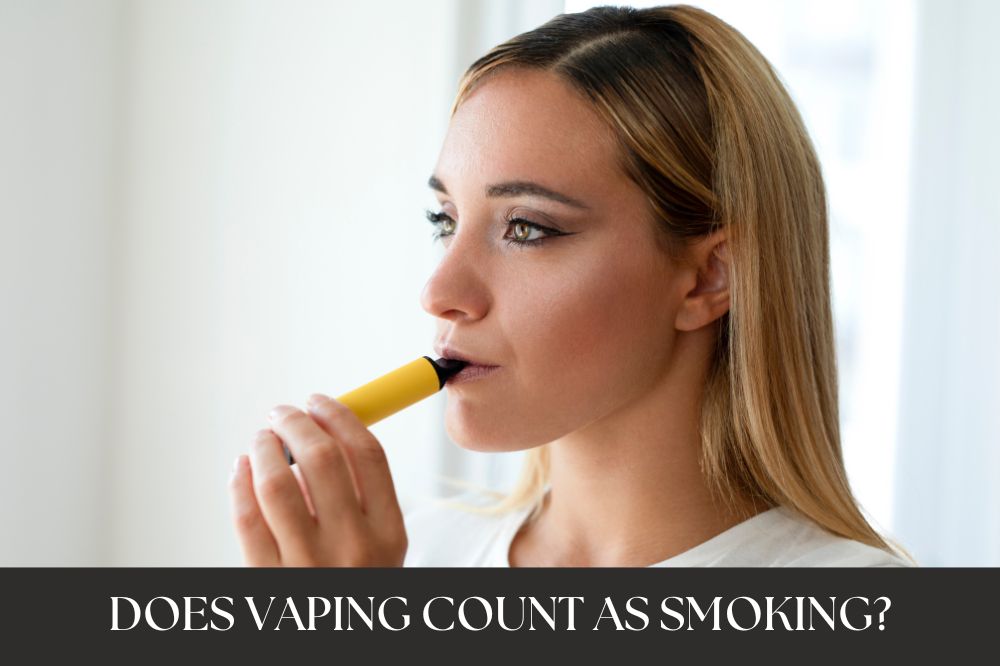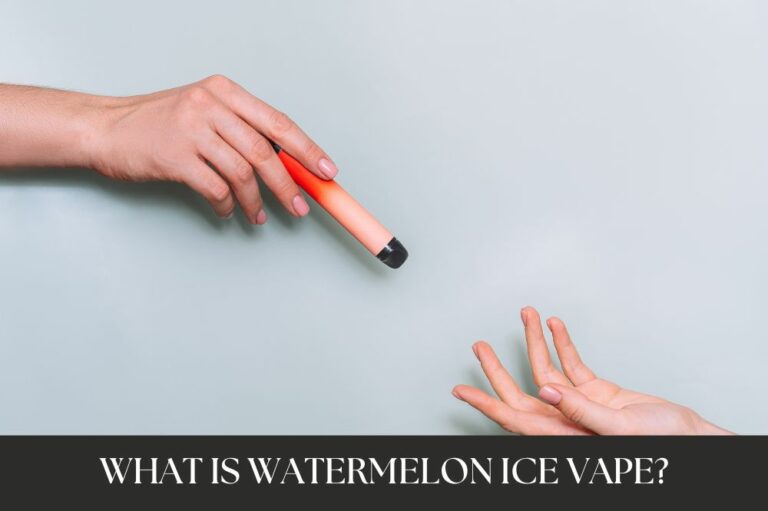
If you’re a smoker looking to quit, you may have heard about vaping as a potential alternative. But does vaping count as smoking? The answer is not as straightforward as you might think. While vaping and smoking both involve inhaling a substance into your lungs, there are some key differences between the two.
One of the biggest differences between vaping and smoking is the substances involved. Traditional cigarettes contain tobacco, which is burned to create smoke that is then inhaled. Vaping, on the other hand, involves inhaling an aerosol that is created by heating up a liquid (usually containing nicotine, flavorings, and other chemicals) in an electronic device. While both substances are inhaled into the lungs, the composition of the aerosol produced by vaping is different from the smoke produced by burning tobacco.
Understanding Vaping and Smoking
Definition of Vaping
Vaping is the act of inhaling and exhaling a vapor produced by an electronic cigarette or other vaping device. Vaping devices, also known as e-cigarettes, come in various shapes and sizes and typically contain a battery, a heating element, and a cartridge or tank that holds the e-liquid, which is a mixture of nicotine, flavorings, and other chemicals.
Definition of Smoking
Smoking is the act of inhaling and exhaling smoke produced by burning tobacco or other substances. Smoking tobacco cigarettes is the most common form of smoking, but people also smoke cigars, pipes, and water pipes.
While both vaping and smoking involve inhaling and exhaling a substance, there are significant differences between the two. Vaping produces a vapor, while smoking produces smoke. Vaping devices do not burn tobacco, while smoking involves burning tobacco or other substances.
Vaping is often marketed as a safer alternative to smoking, but it is important to note that vaping still involves inhaling chemicals and can have negative health effects. Nicotine, the addictive substance found in both vaping and smoking products, can have harmful effects on the brain and body. Additionally, the chemicals used in e-liquids and other vaping products can have negative health effects when inhaled.
SPIRITBAR Katana BP10000
- Slender, leather-textured body reminiscent of a katana handle for an authentic samurai feel
- Unique samurai-inspired e-liquid flavor - fruity yet not too sweet, with a luxurious, elegant aroma
- Powerful 650mAh rechargeable battery for extended vaping time
- Large 18ml e-liquid capacity and 10,000 puff capacity
- Advanced mesh coil and e-liquid & power display screens for optimal vaping experience
The special juice captures the essence of the samurai spirit with its rich, smoothly pulsating flavor that brings new satisfaction with every puff. The device's slender, leather-textured design evokes the grip of a samurai's katana, making this product a perfect choice for beginner vapors.
It is important to understand the differences between vaping and smoking in order to make informed decisions about your health and well-being.
Differences Between Vaping and Smoking
If you’re wondering whether vaping counts as smoking, the short answer is no. Vaping and smoking involve different processes, chemicals, and physical effects. Here are some of the key differences between the two:
SPIRITBAR Jack’s Flask 9000 Puffs
- Stylish pirate flask-shaped body providing an exciting vaping experience
- Delivering up to 9000 puffs per device
- 20ml e-liquid capacity with 50mg nicotine strength for satisfying throat hit
- Specialized pirate-themed e-juice flavors for rich, swirling taste
- Premium mesh coil optimizes flavor profile for maximum vaping enjoyment
This disposable vape captures the daring spirit of the high seas with its flask styling and signature pirate e-juice flavors. The extraordinary battery life provides 9000 indulgent puffs for extended vaping pleasure. Live boldly and freely with the Jack's Flask - a legendary vaping experience fit for a pirate's adventures.
Health Impacts
While both smoking and vaping can have negative health impacts, studies suggest that smoking is more harmful overall. According to Medical News Today, smoking exposes you to more than 7,000 chemicals, many of which are toxic and can cause cancer, heart disease, and other serious conditions. Secondhand smoke can also harm those around you.
Vaping, on the other hand, involves inhaling an aerosol that typically contains nicotine, flavorings, and other chemicals. While some of these chemicals may be harmful, they are generally present in lower concentrations than in cigarette smoke. However, Healthline notes that vaping can still have negative effects on your lungs and overall health, particularly if you use it frequently or for long periods of time.
Chemical Composition
One of the biggest differences between vaping and smoking is the chemical composition of the substances involved. Cigarette smoke contains a complex mixture of chemicals, including tar, carbon monoxide, and formaldehyde. Vaping liquids, on the other hand, typically contain a combination of nicotine, propylene glycol, vegetable glycerin, and flavorings.
While propylene glycol and vegetable glycerin are generally recognized as safe by the FDA, some flavorings and other chemicals used in vaping liquids may be harmful when inhaled. Additionally, the nicotine in vaping liquids can be addictive and have negative health effects.
Physical Differences
Smoking and vaping also differ in terms of their physical effects. Smoking involves burning tobacco, which produces smoke that is inhaled into the lungs. This can lead to lung damage, as well as staining of the teeth and fingers, bad breath, and other cosmetic issues.
Vaping, on the other hand, involves heating a liquid to produce an aerosol that is inhaled into the lungs. This process is generally considered to be less harmful to the lungs than smoking, although it can still cause irritation and inflammation over time.
Overall, while vaping and smoking are different processes with different health impacts, both can have negative effects on your health and well-being. If you’re trying to quit smoking or vaping, there are many resources available to help you, including nicotine replacement therapies, counseling, and support groups.
Legal Perspectives on Vaping and Smoking
When it comes to the legal perspective on vaping and smoking, there are some similarities and differences. Here’s what you need to know:
SPIRITBAR Katana BP10000
- Slender, leather-textured body reminiscent of a katana handle for an authentic samurai feel
- Unique samurai-inspired e-liquid flavor - fruity yet not too sweet, with a luxurious, elegant aroma
- Powerful 650mAh rechargeable battery for extended vaping time
- Large 18ml e-liquid capacity and 10,000 puff capacity
- Advanced mesh coil and e-liquid & power display screens for optimal vaping experience
The special juice captures the essence of the samurai spirit with its rich, smoothly pulsating flavor that brings new satisfaction with every puff. The device's slender, leather-textured design evokes the grip of a samurai's katana, making this product a perfect choice for beginner vapors.
Regulations on Vaping
Vaping is not considered smoking by law in many places. For example, in the United States, e-cigarettes are not considered tobacco products and are therefore not subject to the same regulations as traditional cigarettes. However, some states and localities have passed laws that regulate the use of e-cigarettes in public places, just like traditional cigarettes.
In addition, there are some restrictions on the sale of e-cigarettes and vaping products. In the US, for example, it is illegal to sell e-cigarettes to anyone under the age of 21.
Regulations on Smoking
Smoking is heavily regulated in many places around the world. In the US, for example, smoking is prohibited in many public places, including restaurants, bars, and workplaces. Many states and localities have also passed laws that prohibit smoking in outdoor areas like parks and beaches.
In addition, there are restrictions on the sale of tobacco products. In the US, it is illegal to sell cigarettes to anyone under the age of 21.
It’s important to note that while vaping is not considered smoking by law in many places, it is still important to be aware of local regulations and to be respectful of others when using e-cigarettes in public places.
Public Perception of Vaping Versus Smoking
When it comes to the public perception of vaping versus smoking, there are a few key factors at play. These include social acceptance and marketing influence.
Social Acceptance
Smoking has long been viewed as a negative habit, with significant social stigma attached to it. This has led to a decline in smoking rates over the years, as people have become more aware of the health risks associated with smoking, as well as the negative impact it can have on their social lives.
Vaping, on the other hand, is a relatively new phenomenon, and as such, it has not yet been subject to the same level of social stigma as smoking. However, as vaping has become more popular, there has been a growing concern that it may be seen as a socially acceptable alternative to smoking, which could lead to an increase in vaping rates among young people.
Marketing Influence
Marketing is another key factor that influences the public perception of vaping versus smoking. While tobacco companies have been subject to strict regulations when it comes to marketing their products, the same is not true for vaping companies.
As a result, vaping companies have been able to use a range of marketing tactics to promote their products, including social media campaigns, celebrity endorsements, and product placement in movies and TV shows. This has helped to create a positive image of vaping, which has in turn led to an increase in its popularity.
Overall, while vaping may be seen as a less harmful alternative to smoking, it is important to remember that it is not without its risks. As such, it is important to approach vaping with caution, and to be aware of the potential health risks associated with it.
Effects of Vaping and Smoking on Health
When it comes to the effects of vaping and smoking on your health, it’s important to understand that both can have negative impacts. Here are some of the potential effects of both vaping and smoking:
Long Term Effects
Over time, both vaping and smoking can lead to serious health problems. Smoking is associated with a number of different types of cancer, including lung cancer, as well as heart disease, stroke, and respiratory problems. Vaping is a relatively new phenomenon, so there is less data available on its long-term effects. However, studies have suggested that it may be associated with an increased risk of lung disease and other respiratory problems.
Short Term Effects
Both vaping and smoking can have immediate effects on your body. Smoking can cause shortness of breath, coughing, and other respiratory symptoms, as well as decreased sense of taste and smell. Vaping can also cause shortness of breath and coughing, as well as headaches, dizziness, and nausea.
It’s important to note that while vaping is often marketed as a safer alternative to smoking, it’s still not a healthy habit. Vaping products contain a variety of chemicals, including nicotine, which is highly addictive. In addition, some vaping products have been found to contain harmful substances like heavy metals and formaldehyde.
Overall, it’s best to avoid both vaping and smoking if possible. If you’re struggling to quit, there are resources available to help you kick the habit. Talk to your doctor or a smoking cessation specialist for more information.








